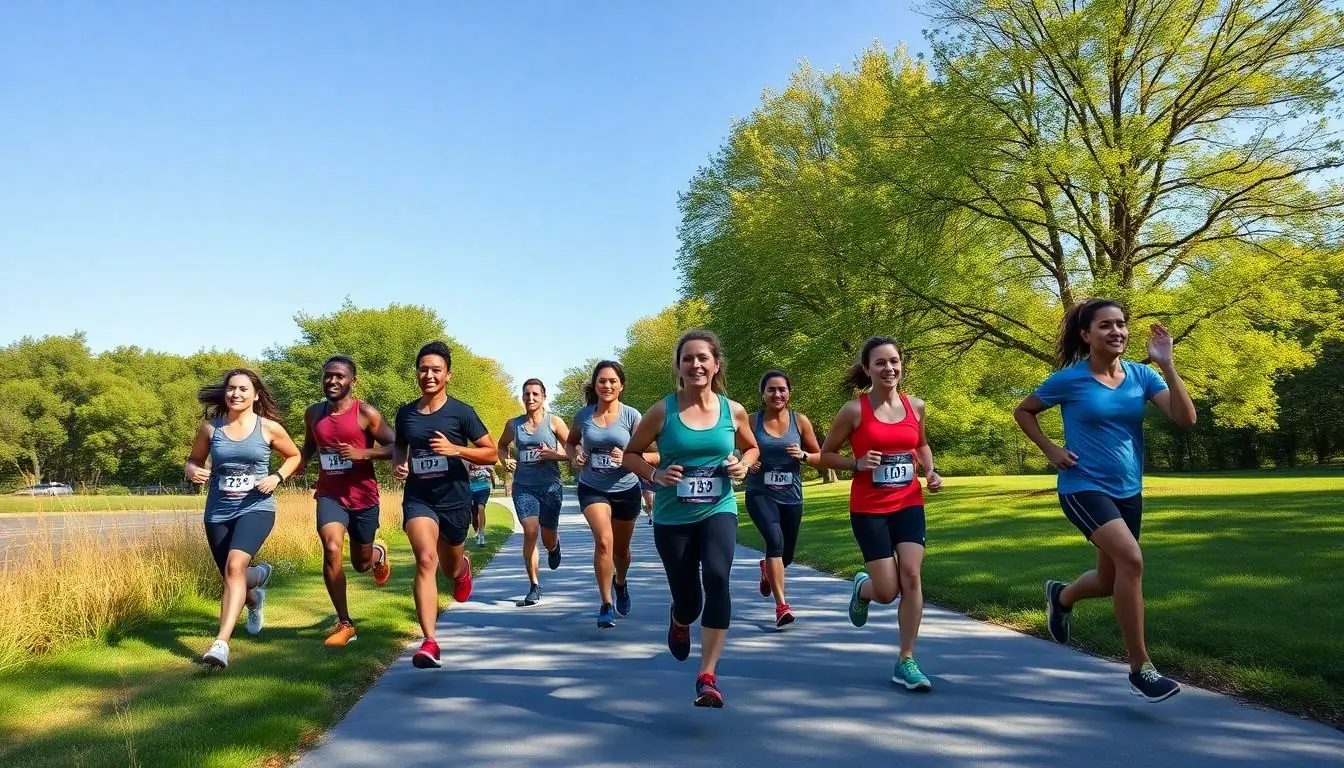Table of Contents
ToggleWhen it comes to choosing between running and cycling, it’s like picking your favorite child—both have their perks and quirks. Running offers that exhilarating rush of pounding the pavement, while cycling lets you breeze through the scenery like a superhero on wheels. Each sport has its devoted fans, and the debate rages on: which one reigns supreme in the battle for fitness glory?
Overview of Running vs Cycling
Running and cycling both serve as popular forms of cardiovascular exercise. Each discipline brings distinct advantages and appeals to different individuals. Serious runners often emphasize the benefits of weight-bearing activity, which strengthens bones and muscles. Enthusiasts typically enjoy the thrill of high-intensity workouts that promote endurance and fat loss.
Cycling, on the other hand, offers a low-impact alternative preferable for those with joint issues. Many cyclists appreciate the ability to cover vast distances while enjoying the outdoors. This activity allows for more varied scenic routes that enhance the experience. Speed and ease of travel become bonuses when comparing these activities.
Time investment often differs significantly between the two. A typical running session may last from 30 to 60 minutes, while cyclists often pedal for an hour or longer to yield similar benefits. Both exercises contribute to cardiovascular health, but they do so in unique ways. Runners benefit from quick calorie burning, while cyclists enjoy sustained efforts that increase stamina.
In terms of equipment, running requires minimal gear—just a good pair of shoes. Cyclists, however, need a bike and additional essentials like helmets and proper attire. Consideration of safety is crucial for both activities, particularly in urban settings.
Injury rates can vary as well. Runners frequently encounter overuse injuries such as shin splints and runner’s knee. Cyclists may face risks from falls or crashes, emphasizing the need for caution. Preference often depends on personal conditioning levels, accessibility, and individual fitness goals. Understanding these factors helps individuals decide which activity aligns best with their lifestyle.
Benefits of Running

Running offers numerous advantages that significantly benefit one’s overall well-being. Enhanced cardiovascular fitness stands out among these, as regular running strengthens the heart and improves blood circulation.
Physical Health Benefits
Running aids in weight management, promoting fat loss and muscle retention. An individual burns approximately 100 calories per mile, making it an efficient calorie-burning exercise. Stronger bones develop due to the weight-bearing nature of running, reducing the risk of osteoporosis. Increased lung capacity occurs with consistent running, which also enhances overall stamina and endurance. Improved coordination and balance are often reported by runners, fostering greater athleticism in daily activities. Engaging in running regularly also lowers the risk of chronic diseases such as diabetes and hypertension.
Mental Health Benefits
Running positively impacts mental health by reducing anxiety and depression symptoms. Releasing endorphins during a run often leads to a boost in mood, commonly referred to as the “runner’s high.” This form of exercise can also improve cognitive function, leading to sharper focus and better concentration in daily tasks. Social interactions increase when participating in running groups or events, enhancing feelings of community and belonging. Personal achievements in running foster a sense of accomplishment, building self-esteem and confidence over time. Moreover, the rhythmic nature of running allows for a meditative state, providing clarity and stress relief.
Benefits of Cycling
Cycling offers numerous advantages that positively impact physical and mental health.
Physical Health Benefits
Cycling enhances cardiovascular fitness by increasing heart rate and improving circulation. Studies indicate that cyclists experience lower risks of obesity due to effective calorie burning. Approximately 300 calories per hour can burn during moderate cycling sessions, making it a valuable workout option. Joint stress is significantly reduced when compared to high-impact exercises, which prevents injuries. Stronger leg muscles develop through regular cycling, fostering endurance and stability. Additionally, cycling promotes better lung capacity, as it encourages deeper breaths during rides.
Mental Health Benefits
Cycling boosts mental well-being, alleviating feelings of stress and anxiety. Those who cycle regularly report improved mood states due to the release of endorphins. Enhanced cognitive function occurs with consistent cycling sessions, as oxygen circulation to the brain improves. Group rides provide opportunities for social interaction, which fosters a sense of community. Enjoying scenic routes allows individuals to connect with nature, promoting mindfulness and relaxation. As cyclists achieve personal fitness goals, self-esteem and confidence increase, further contributing to overall mental health.
Comparing the Two Activities
Both running and cycling offer distinct advantages. Understanding the differences in caloric burn and muscle engagement can help individuals choose the best fit for their fitness goals.
Caloric Burn
Running typically burns more calories per minute compared to cycling. A runner burns approximately 100 calories per mile, making it effective for those focused on rapid weight loss. In contrast, cycling at a moderate pace burns around 300 calories per hour. The intensity of the workout plays a significant role in caloric expenditure. High-intensity cycling can effectively increase calorie burn, especially over longer sessions. Individuals may find running more beneficial for shorter, high-paced workouts when aiming for quicker results. Ultimately, personal preferences and workout styles can influence one’s choice based on caloric goals.
Muscle Engagement
Running emphasizes the engagement of lower body muscles, particularly the quadriceps, hamstrings, and calves. It promotes strong bone density through weight-bearing motion, critical for long-term health. Cycling, however, strengthens leg muscles primarily through resistance applied during pedaling. This low-impact exercise targets the quads, glutes, and calves while minimizing stress on joints, making it suitable for those with injury concerns. Distinct muscle groups become engaged based on workout variants, such as road cycling or mountain biking. Consequently, incorporating both activities into a fitness routine can provide balanced muscle development and endurance enhancement.
Choosing the Right Activity for You
Selecting the ideal exercise hinges on various factors, including personal fitness goals and accessibility. Understanding these factors ensures individuals make informed choices.
Personal Fitness Goals
Personal fitness goals play a crucial role in deciding between running and cycling. Individuals aiming for rapid weight loss might favor running, as it burns approximately 100 calories per mile. On the other hand, moderate cycling sessions burn around 300 calories per hour, appealing to those focused on endurance. Injury prevention matters too; those with a history of joint issues often opt for cycling due to its low-impact nature. Athletic performance enhancement can also guide choices, since running improves bone density while cycling builds leg muscle strength. Assessing these priorities can streamline the decision-making process.
Accessibility and Environment
Accessibility and environment significantly influence the choice between running and cycling. Running requires minimal equipment, mainly a good pair of shoes, making it accessible for most individuals. Cyclists, however, need a bike along with safety gear, which may pose logistical challenges. Local routes also matter; those living near scenic trails might find cycling more enjoyable, while urban areas could favor running through parks or city streets. Weather conditions can affect preferences as well; unfavorable weather may prompt individuals to choose indoor cycling over outdoor running. Recognizing these factors enhances the likelihood of sticking to an exercise routine.
Choosing between running and cycling ultimately depends on individual preferences and fitness goals. Both activities offer unique benefits that cater to different needs. Runners enjoy quick calorie burn and enhanced bone strength while cyclists benefit from low-impact workouts that promote endurance and joint health.
Incorporating both into a fitness routine can lead to a well-rounded approach to health. Whether it’s the thrill of hitting the pavement or the joy of exploring scenic trails on a bike, the key is to find what resonates most. This not only ensures consistency but also enhances overall well-being.




